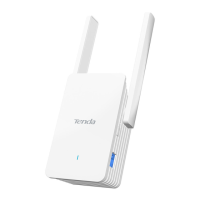
Do you have a question about the Tenda A27 and is the answer not in the manual?
| Ethernet LAN | Yes |
|---|---|
| Cabling technology | 10/100/1000Base-T(X) |
| Networking standards | IEEE 802.11ax |
| Ethernet LAN data rates | 10, 100, 1000 Mbit/s |
| Ethernet LAN interface type | Gigabit Ethernet |
| Antennas quantity | 2 |
| Antenna gain level (max) | 5 dBi |
| DC input voltage | 12 V |
| DC output current | 1 A |
| Power source type | DC |
| Power consumption (max) | 11 W |
| Wi-Fi band | Dual-band (2.4 GHz / 5 GHz) |
| Frequency band | 2.412-2.484, 5.15-5.25, 5.725-5.85 GHz |
| Output power (dBm) | 2.4GHz (2412 MHz~2472 MHz):19.97dBm 5GHz (5150 MHz~5250 MHz; 5250 MHz~5350 MHz; 5470 MHz~5725 MHz):22.99dBm |
| Top Wi-Fi standard | Wi-Fi 6E (802.11ax) |
| Receiver sensitivity | 2.4 GHz 11b-1M:-97dBm 11g-54M:-76dBm 11n-20M-MCS7:-74dBm 11n-40M-MCS7:-72dBm 5 GHz: 11a-6M:-95dBm 11n-20M-MCS7:-74dBm 11n-40M-MCS7:-72dBm 11ac-80M-MCS9:-63dBm |
| WLAN data transfer rate (max) | 1800 Mbit/s |
| Security algorithms | WPA-PSK, WPA-TKIP, WPA2-PSK, WPA3 |
| Product type | Network repeater |
| Product color | White |
| Quantity per pack | 1 pc(s) |
| Connectivity technology | Wired & Wireless |
| Ethernet LAN (RJ-45) ports | 1 |
| Certification | CE, FCC、RoHS |
| Storage temperature (T-T) | -40 - 70 °C |
| Operating temperature (T-T) | 0 - 40 °C |
| Storage relative humidity (H-H) | 5 - 90 % |
| Operating relative humidity (H-H) | 10 - 90 % |
| Harmonized System (HS) code | 85176990 |
| Depth | 72 mm |
|---|---|
| Width | 123 mm |
| Height | 47.5 mm |
Provides a general description of the WiFi 6 dual-band extender's capabilities and features.
Describes the physical appearance, including the LED indicator.
Explains the meaning of different LED indicator colors and patterns for status indication.
Details the function and purpose of the device's ports and buttons like WPS and RESET.
Introduces the two working modes (Extender and AP) for initial setup.
Guides users through setting up the extender in Extender mode using Web UI or WPS.
Provides instructions for configuring the extender in Access Point mode.
Step-by-step guide to access the web UI using a computer via Ethernet.
Instructions for accessing the web UI using a mobile phone or tablet.
Explains the main components of the web interface: navigation bar and configuration area.
Describes the function of common buttons like 'Save' and 'Cancel' within the web UI.
Shows how to determine if the WiFi network extension was successful.
Provides information on the extender's connection status to the upstream device and internet.
Displays the count of devices currently connected to the extender's WiFi network.
Shows how to check the WiFi names of the extender and the upstream device.
Detailed steps for re-extending the WiFi network, including selecting bands and saving settings.
Introduces options for managing WiFi parameters like unification, names, and passwords.
Explains how to combine 2.4 GHz and 5 GHz bands into a single WiFi network.
Guides on how to configure separate WiFi networks for 2.4 GHz and 5 GHz bands.
Instructions for changing the WiFi network name (SSID) and password.
Details how to hide the WiFi network name for increased security.
Explains the process of manually connecting to a hidden WiFi network.
Introduces viewing connected clients, blacklisting, and managing access.
Shows how to view currently connected clients and the list of blocked devices.
Instructions for blocking specific devices from connecting to the network.
Guides on how to unblock devices that were previously added to the blacklist.
Step-by-step guide to change the extender's operation from Extender to Access Point mode.
Step-by-step guide to change the extender's operation from Access Point back to Extender mode.
Configure IP address, subnet mask, and gateway settings for the extender.
Explains and enables the OFDMA feature for improved WiFi performance.
Manage the LED indicator, including enabling, disabling, or scheduling it.
Set or change the password used to access the extender's web UI.
Configure system time synchronization (internet/local) and Daylight Saving Time (DST).
Perform system maintenance like rebooting, resetting, exporting logs, and upgrading firmware.
Guides on how to configure a computer's IPV4 address settings in Windows 10.
Lists the default configuration values for the WiFi extender.
Provides full spellings for technical acronyms and abbreviations used in the manual.